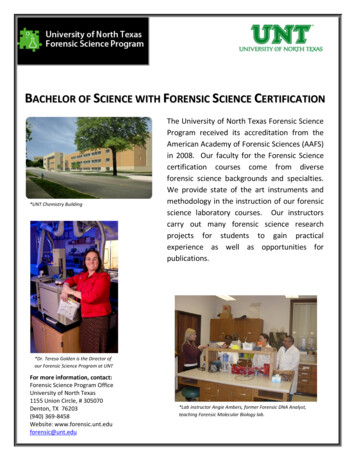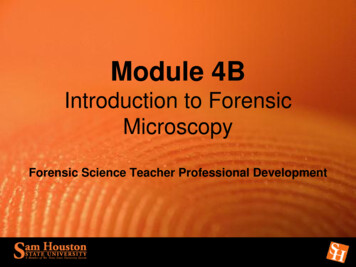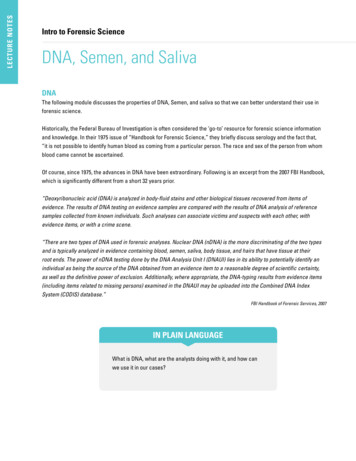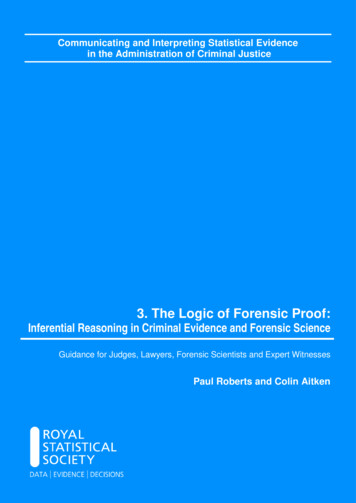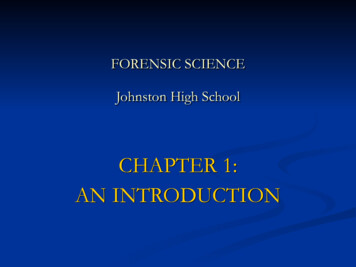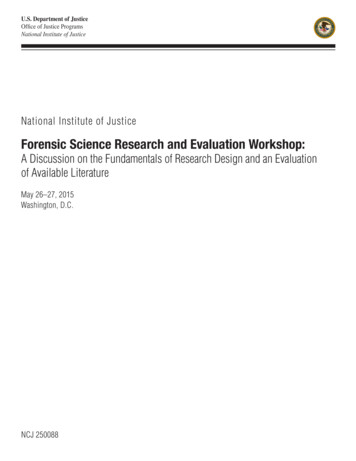
Transcription
U.S. Department of JusticeOffice of Justice ProgramsNational Institute of JusticeNational Institute of JusticeForensic Science Research and Evaluation Workshop:A Discussion on the Fundamentals of Research Design and an Evaluationof Available LiteratureMay 26–27, 2015Washington, D.C.NCJ 250088
U.S. Department of JusticeOffice of Justice Programs810 Seventh St. N.W.Washington, DC 20531Loretta E. LynchAttorney GeneralKarol V. MasonAssistant Attorney GeneralNancy Rodriguez, Ph.D.Director, National Institute of JusticeThis and other publications and products of the National Institute of Justice can be found at:National Institute of JusticeStrengthen Science Advance Justicehttp://www.nij.govOffice of Justice ProgramsInnovation Partnerships Safer Neighborhoodshttp://www.ojp.usdoj.govThe National Institute of Justice is the research, development and evaluation agency of the U.S. Department of Justice. NIJ’smission is to advance scientific research, development and evaluation to enhance the administration of justice and public safety.The National Institute of Justice is a component of the Office of Justice Programs, which also includes the Bureau of JusticeAssistance; the Bureau of Justice Statistics; the Office for Victims of Crime; the Office of Juvenile Justice and DelinquencyPrevention; and the Office of Sex Offender Sentencing, Monitoring, Apprehending, Registering, and Tracking.
Forensic Science Research and Evaluation WorkshopA Discussion on the Fundamentals of Research Design and an Evaluation of Available LiteratureEdward G. Bartick and McKenzie A. Floyd, Eds.
Forensic Science Research and Evaluation Workshop:A Discussion on the Fundamentals of ResearchDesign and an Evaluation of Available LiteratureThis publication is based on a workshop funded by a National Science Foundation grant (SMA1533843) from the Science of Science and Innovation Policy and Biological AnthropologyPrograms in the Directorate for Social, Behavioral and Economic Sciences (SBE), andthe National Institute of Justice (NIJ), Office of Justice Programs, U.S. Department of Justice(DOJ).Any opinions, findings, and conclusions or recommendations expressed in this material arethose of the author(s) and do not necessarily reflect the views of the National ScienceFoundation or the Department of Justice.The workshop was conducted at the American Association for the Advancement of Science(AAAS), Washington, DC, May 26-27, 2015.Edward G. Bartick, Ph.D.Principle Investigator/Manager&McKenzie Floyd, B.A., M.S.RapporteurThe George Washington UniversityDepartment of Forensic Sciences2100 Foxhall RoadWashington, DC 20007May 6, 2016
Table of ContentsPageEdward G. Bartick . 1OverviewSection 1: Experimental Design and StatisticsChapter1. Plenary I. The State of Research in the Forensic Sciences2. Experimental Design in the Physical Sciences3. Experiments in the Social Sciences4. Non-Experimental Research in AnthropologyConstantine Gatsonis 5Stephen L. Morgan 11Dietram Scheufele . 17Marilyn London andKevin G. Hatala 235. Appropriate StatisticsJoseph B. Kadane . 296. Discussion Summary 35Section 2: Interpretation and AssessmentChapter1. Plenary II. Topic: Scientific Impact of Problematic LiteratureTitle: Pernicious, Pervasive, and Persistent Literature inFire InvestigationJohn J. Lentini . 362. Why Scientists Make Mistakes in Conducting andReporting their ResearchMichael Shermer . 413. Re-examining Peer ReviewOrla M. Smith . 50Recognition and Mitigation of Cognitive Bias in ForensicScience: From Crime Scene Investigation to ForensicResearch and LiteratureItiel Dror . 534. Treatment of Error and Uncertainty in the Literature:A Source of Enlightenment and ConfusionTed Vosk . 605. Impact of Forensic Literature on the AdmissibilityProcessMichael Ambrosino. 656. Discussion Summary 68Section 3: Policy ImplicationsChapter1. Plenary III. Policy Implications of Inadequate Literature Ronald Kostoff . 692. A Quality and Gap Analysis: An AAAS Forensic ScienceLiterature ProjectDeborah Runkle 733. A View from a member of the National Commission onForensic Science: A Perspective on Deliberations AboutForensic Science and The Path ForwardS. James Gates, Jr. 814. How do We Gain Faith in the Scientific Literature?Simon Cole . 885. Government’s Role in Funding Scientific ResearchEdward G. Bartick 966. Looking to the Future of Forensic Science Impacted byOSAC Standards ActivitiesMark Stolorow . 1007. Discussion Summary 107i
Section 4: SummaryGeneral Considerations for the Evaluation of Forensic Science Literature . 108Acknowledgements . 110Appendix II. National Commission on Forensic Science, Scientific Inquiry and ResearchSubcommittee Views Document: Scientific Literature in Support of ForensicScience and Practice. . 1 of 4ii
OverviewEdward G. BartickIntroductionThis publication is based on a “Forensic Science ResearchEvaluation Workshop” sponsored by the NSF and the NIJ and was held atthe AAAS headquarters in Washington, DC. The impetus for the workshopwas recent criticisms of the forensic sciences from public, legal, andscientific sources. One of the more important critical reports was the 2009National Research Council report, Strengthening Forensic Science in theUnited States: A Path Forward.1 It was highly critical of the scientific foundations for several ofthe forensic disciplines, declaring that “Little rigorous systematic research has been done tovalidate the basic premises and techniques in a number of forensic science disciplines.” and “ astatistical framework that allows quantitation is greatly needed.”1 p.189.Statistical frameworks for reporting the significance of physical evidence have onlyrecently been pursued broadly. Since the early1990s, DNA analysis testimony began stating theprobability of matches between question and known evidence and is the only forensic disciplinewhere it has been routinely applied. With the statistics of DNA analysis being well addressed,researchers have begun to look at a mathematical and statistical basis for pattern comparisonanalysis such as latent fingerprints,2 fired bullets,3 and toolmarks.4 Materials such as paints,fibers, and tapes that are often found as physical evidence at crime scenes could be of greatervalue should we establish a statistical significance of an association with a suspect or victim.Knowing the abundance and variation in composition of these materials could be used toestablish probability estimates of these materials randomly being found at the scene. Historicallythere has been resistance to this approach, because information on manufactured materials hasbeen considered to be too difficult to maintain due to production changes. However, theestablishment of well-maintained centralized databases are possible and should be developed.5A second critical review of the forensic sciences by Mnookin, et al.6 reported that the forensicsciences must develop - a well-established scientific foundation. This can only beaccomplished through the development of a research culture that permeates theentire field of forensic science. A research culture must be grounded in the valuesof empiricism, transparency, and a commitment to an ongoing critical perspective.More recently, in January 2015 the National Commission of Forensic Sciences (NCFS)Subcommittee on Scientific Inquiry and Research7 expressed a dire need for more rigorousstandards of scientific research and resulting publications in the area of forensic science.6With the foundations of forensic science under scrutiny, there is a general call to reviewthe forensic science literature for strengths and weaknesses. This must be done by practitioners,1
and forensic scientist researchers in collaboration with academic scientists in traditionaldisciplines. Research articles determined to be sound science should be used to incorporateanalytical methodology into standards for laboratory analysis. Currently, such standards arebeing addressed by the National Institute of Standards and Technology’s (NIST) Organization ofScientific Area Committees (OSACs)7 and hopefully will be evidence-based.However, the ability of today’s forensic scientists to properly evaluate the forensicliterature has been called into question and a need to establish a research culture to “placethemselves on an appropriately secure foundation in the twenty-first century”6 has beenpostulated. This criticism relates to the training forensic scientists undergo. Typically, forensicscience educational programs do not offer full courses or other opportunities for students to learnresearch methods in any depth. Statistics is not a requirement of the Forensic Science EducationPrograms Accreditation Commission (FEPAC) for a Masters of Forensic Science graduateprogram. FEPAC requires a research project culminating in a report “suitable for publication”.However, without the teaching of research methods, rigorous research is not possible. TheMaster’s level is typically the terminal degree for practitioners in the forensic sciences. Researchtraining, extensive investigations, and publishing are required for PhD degrees and are key to thedevelopment of a research culture. In the USA, only one recently established doctorate programcurrently offers a PhD in forensic science, a few universities offer interdisciplinary programswith a forensic science track, and a few programs confer PhD in forensic chemistry, forensicmolecular biology, or forensic toxicology. Consequently, most practicing forensic scientists areneither equipped to evaluate the research papers of others, nor to conduct the quality of researchthat would be expected of an academic discipline.Our workshop was formed to discuss the fundamentals of research design and theevaluation of the literature. The NCFS recognized that forensic scientists and the OSACs wouldbenefit from tools to help them assess the scientific literature in order to conform to higherscientific standards in critical thinking and laboratory performance. We hope that this publicationwill provide some grist for evaluating and elevating the research efforts in the forensic sciencesand that it may be useful to OSAC members, advanced practitioners, and peer reviewers of thebasics of research and evaluation of forensic science literature, as well as for Directors of Masterof Forensic Science educational programs.Organization of the workshopAll participants were selected by a planning committee as listed in theacknowledgements. The committee decided on three subject areas, each consisting of a half-daysession as follows: 1) experimental design and statistics; 2) interpretation and assessment, and; 3)policy implications. The sessions are listed as sections in this publication.The goal was to bring together a range of 17 experts in the experimental and behavioralsciences, law, policy and government funding to address the need for a higher standard offorensic science research. Each session consisted of one plenary speaker and four to fiveadditional speakers. Each speaker had one-half hour to present their topic. A panel discussionwas held the end of each session with questions from the other workshop participants and guests.2
Each participant has submitted a short essay of the topic they presented at the workshop,and those write-ups are included here in this publication. Additional observations andconclusions were made during the panel discussions and these are outlined after the write-ups ofeach section. The essays and discussions are listed are listed as chapters in this publication.As a summary, there is an outline of topics to evaluate the forensic science literature.The outline provides important considerations when reviewing submitted papers for publication,planning a research project, or simply determining the scientific quality of the forensic literature.This report is intended to be a guide to plan forensic science research and assess its literature.The topics are not all-inclusive and are meant as a starting point for assessment. Each topicalwrite-up has significant references to assist in a greater depth of background on the subject. Foreach particular discipline within the forensic sciences, evaluators will need a thoroughknowledge base of the specific discipline to properly evaluate writings. If the evaluator is notstrong in statistics, it is recommended that they confer with a statistician. A close look will berequired to determine if the statistics used are appropriate.Edward G. (Ed) Bartick is a research professor at The George Washington UniversityDepartment of Forensic Sciences, Washington, DC, who is involved in the development offorensic analytical methods of evidential materials. Dr. Bartick completed a Ph.D. at the Instituteof Materials Science at U. Connecticut in 1978. He has worked for pharmaceutical, instrument,and a materials production companies doing analytical development. In 1986, he joined the FBILaboratory as a research scientist in forensic methods development. In 1991 he started a oneweek class entitled “Infrared Spectrometry for Trace Analysis” for forensic examiners. Dr.Bartick has acted as research advisor for Ph.D. and M.S. graduate students from U. Virginia,Virginia Tech, and George Washington U. on forensic vibrational spectroscopy thesis projects atthe FBI Academy. In January 2007, He retired from the FBI to direct the Forensic ScienceProgram at Suffolk U. in Boston where he expanded the curriculum. He returned to theWashington, D.C., area to join GWU 2013. Dr. Bartick has authored 60 technical publications,including 11 book chapters. He was awarded the FBI Director's Award in 1994 and 1996. In1994 he founded the Scientific Working Group for Materials Examination (SWGMAT). Hechaired the group through 1997 and continued to play an active role as chair of the DatabaseSubgroup until spring of 2014 when the Organization of Scientific Area Committees (OSACs) atNIST assumed the role of SWGs. Dr. Bartick is a Fellow of the American Academy of ForensicSciences, a charter member of American Society of Trace Evidence Examiners (ASTEE), amember of the American Chemical Society and the Society for Applied Spectroscopy.ebartick@gwu.edu3
References1. Committee on Identifying the Needs of the Forensic Sciences Community, NationalResearch Council. Strengthening Forensic Science in the United States: A Path Forward.Washington, DC: The National Academies Press, 2009.2. Stephen J. Taylor, Emma K. Dutton, Patrick R. Aldrich, Bryan E. Dutton Application ofSpatial Statistics to Latent Print Identifications: Towards Improved Forensic ScienceMethodologies NCJRS Report, 0590.pdf3. Bacharach B A. Statistical Validation of the Individuality of Guns Using 3D Images ofBullets. NCJRS Report, 2006. pdf4. Petraco NDK, Chan H, De Forest PR, Diaczuk P, Gambino C, Hamby J, KammermanFL, Kammrath BW,.Kubic TA, Kuo L, McLaughlin P, PetilloG, Petraco, NPhelps, M.S.;Peter A. Pizzola EW, Purcell DK, Shenkin P, Application of Machine Learning toToolmarks: Statistically Based Methods for Impression Pattern Comparisons, NCJRSReport, 2012. pdf5. Bartick EG, Roberts K, Morgan SL, Goodpaster JV. A Statistical Approach to theDiscrimination and Match Capability to Provide Scientific Basis for EstimatingSignificance of Fiber Association in Forensic Practice. In: Proceedings of the AmericanAcademy of Forensic Sciences Annual Meeting; 2013 Feb 18-23; Washington (DC); 90.6. Mnookin JL, Cole SA, Dror IE, Fisher, BA, Houck, MM, Inman, K, Kaye, DH, Koehler,JJ, Langenburg, G, Risinger DM, Rudin, N, Siegel, Stoney, DA. The Need for a ResearchCulture in the Forensic Sciences, 58 UCLA Law Review, 725-779 (2011).7. National Commission on Forensic Science, Scientific Inquiry and ResearchSubcommittee. Views Document: Scientific Literature in Support of Forensic Scienceand Practice. http://www.justice.gov/ncfs/file/786591/download8. National Institute of Standards and Technology, Organization of Scientific AreaCommittee. http://www.nist.gov/forensics/osac.cfm4
Section 1: Experimental Design and StatisticsPlenary I.The Status of Research in the Forensic SciencesConstantine Gatsonis1. Scientific challenges in the multidisciplinary world of the forensicsciencesThe NAS report on Strengthening Forensic Science1 examinedboth the science and the practice in the forensic disciplines across thecountry. The report discussed a broad range of challenges facing theforensic science community, from disparities in resources, facilities andtraining across the country’s jurisdictions to lack of mandatorystandardization, certification, and accreditation and to political realitiesand evidence admissibility issues. The report also documented uneven development of the broadrange of forensic disciplines and called for major emphasis on developing scientific research andeducational programs in the forensic sciences.Any examination of the forensic sciences should start by recognizing theirmultidisciplinary nature. Indeed, the more advanced forensic disciplines draw methods andexpertise from a variety of scientific disciplines. For example, nuclear DNA and mitochondrialDNA analysis originated in molecular biology; and substance identification uses methods fromanalytical chemistry. Such forensic disciplines are generally based on solid scientific groundsbecause the validity of those methods has been established through past and ongoing researchand development. If the analyses are executed according to the principles of science, they can bevery reliable.As an example, when a sample is matched to an individual using DNA analysis, theanalysis can also provide an estimate of the probability that the sample could have belonged toanother individual. This is known as the “random match probability” and is typically very small.There are many reasons why the science of DNA analysis rests on a solid foundation including:i) the extensive, peer-reviewed research behind the biological explanations for individualspecific findings; ii) the probabilities of false positives having been explored and quantified insome settings (even if only approximately); iii) the laboratory procedures being well specifiedand subject to validation and proficiency testing; and iv) the clear and repeatable standards foranalysis, interpretation, and reporting. In contrast to DNA analysis, when a fingerprint isdeclared a “match” it is not yet feasible to estimate the probability that the print could belong tosomeone else (i.e., random match probability.) Just as concerning, examiners typically expresstheir findings in a yes/no fashion, without reference to the error probabilities. Finally, thereproducibility of the results is different between these two types of analysis.5
Beyond DNA and chemical analyses, a good number of forensic disciplines work on theidentification of patterns. The analysis in these disciplines examines whether it is possible to linka pattern from a crime scene—which may be a latent fingerprint impression, markings on a spentbullet, patterns from a fire, blood-spatter patterns, and so on—with analogous patterns from aweapon, tool, finger, etc., associated with a suspect. The vast majority of these methods havebeen developed by the forensic science community, with little input from the broader world ofscience.The NAS report notes that “The level of scientific development and evaluation variessubstantially among the forensic science disciplines [w]ide variability exists across forensicscience disciplines with regard to techniques, methodologies, reliability, error rates, reporting,underlying research, general acceptability, and the educational background of its practitioners”.The report then calls for research to address issues of accuracy, reliability, and validity in theforensic science disciplines. In particular, the research needs include: (a) The conduct of studiesestablishing the scientific basis for demonstrating the validity of forensic methods; (b) Thedevelopment and establishment of quantifiable measures of reliability and accuracy of forensicanalyses. The corresponding studies should reflect as closely as possible the actual practice usingrealistic case scenarios and should develop estimates of performance measures which areaveraged across a representative sample of forensic scientists and laboratories; (c) Thedevelopment of quantifiable measures of uncertainty in the conclusions of forensic analyses; (d)The development of automated techniques capable of enhancing forensic technologies; and (e)The conduct of studies of human observer bias and the sources of human error and contextualbias in forensic examinations. Importantly, the NAS report stresses that research in the forensicsciences should be peer reviewed and published in respected scientific journals.2. Elements of an evaluation of the accuracy of forensic analyses.Understanding and quantifying statistical uncertainty and the magnitude of potential errorin scientific results are fundamental objectives in the sciences, including the forensic sciences.For example, laboratory analyses are subject to measurement error (i.e. uncertainty about truequantity); fingerprint analyses can lead to false identification of individual prints because ofobserver error or low specimen quality; DNA analyses can lead to false identification ofindividuals because of contamination of samples or laboratory errors.Fuzzy use of language has been pervasive in discussions of errors and error rates in theforensic disciplines. In this section we describe basic concepts of the assessment of error inmaking the two common types of binary determinations in forensic analyses, individualizationand classification. The former addresses the question of whether a piece of evidence can beattributed to a specific source. For example, was a particular fingerprint obtained from a specificindividual? The latter addresses the question of whether a piece of evidence can be attributed to aclass of sources. For example, was a piece of car paint obtained from a specific car model? Atpresent, few forensic modalities have potential for addressing individualization questions butseveral of them have potential for addressing classification questions.2.1 Accuracy for classification tasksStudies of the accuracy of a forensic analysis to perform classification tasks can bedeveloped using the established methods for assessing the accuracy of diagnostic tests. In such6
studies units are classified by the test (in our case the forensic analysis) and by a referencestandard. Importantly, the test result needs to be generated without knowledge of the referencestandard. When a total of n units are classified by both test and reference standard, the results canbe presented in Table 1. For example, a question of interest in hair analysis may be whether aparticular specimen belongs to individuals from a particular group G. Thus the analysis woulddeclare whether the specimen comes from an individual from group G or not and the referencestandard would provide the definitive information on the particular individual.Table 1.Forensic analysis resultReference standard (Truth)“yes”“no”“yes” (Target conditionpresent)TPFN(True Positives)(False Negatives)“no” (Target conditionabsent)FPTN(False Positives)(True Negatives)The accuracy of the forensic analysis can be assessed from the perspective of detection orprediction. The two perspectives are distinct and complementary to each other.For detection, we derive two key measures of performance: Sensitivity, defined as the probability that the analysis will detect the target conditionwhen the target condition is present.Specificity, defined as the probability that analysis will declare the target condition is notthere when the target condition is absent.In the notation of the table, the sensitivity would be estimated by the fraction TP/(TP FN) andthe specificity would be estimated by the fraction TN/(FP TN). The corresponding measures oferror are given by (1-sensitivity), estimated by FN/(TP FN), and (1- specificity), estimated byFP/(FP TN). The total sum of the counts in the four cells of the table equals n.For prediction, we also derive two key measures of performance: Positive predictive value (PPV), defined as the probability that the target condition ispresent, given that the analysis result indicated its presence.Negative predictive value (NPV), defined as the probability that the target condition isabsent, given that the analysis result indicated it is absent.In the notation of the table, the PPV would be estimated by the fraction TP/(TP FP) and thespecificity would be estimated by the fraction TN/(FN TN). The corresponding measures oferror are given by (1-PPV), estimated by FP/(TP FP), and 1- NPV, estimated by FN/(FN TN).7
An extensive literature on the design and analysis of studies of diagnostic and predictiveaccuracy of tests is available and can be used for the assessment of forensic modalities as well2.In particular the literature includes methods for quantifying the statistical uncertainty ofestimates of diagnostic and predictive accuracy, assessing the potential impact of covariates onaccuracy, and quantifying the extent of variation in accuracy between individual analysts andlaboratories.2.2 Accuracy for individualization tasksThe approach for assessing classification accuracy can also be used to assess the accuracyof analyses aiming at individualization. For example, in such an experiment one or morefingerprint analysts examine pairs of prints. Some of the pairs are prints from the same individualand others from different individuals. Thus each pair will be classified as “match” or “not match”by the analyst and the reference standard. The 2x2 table from an experiment involving a singlerating per pair would be as in Table2.Table 2.Fingerprint analysis resultReference standard (“Truth”)matchnot matchPair of prints comes from sameindividual (true match)TPFN(True Positives)(False Negatives)FPTN(False Positives)(True Negatives)Pair of prints comes from differentindividuals (true not match)Data from this type of experiment can be used to estimate error rates for fingerprintanalysis using the statistical methods discussed in the previous section for classification tasks. Arecent example of such a study was the evaluation of the accuracy of fingerprint analysisconducted by the FBI Laboratory.3 Studies can also be designed to evaluate the performance ofindividual analysts and/or groups of analysts and to evaluate the impact of such factors as latentprint quality and analyst training.3. Experience from other disciplinesResearch on the accuracy and reliability of forensic modalities can benefit fromparadigms developed in other branches of science, notably diagnostic medicine and clinicalchemistry. An extensive, rigorous, and on-going research enterprise underlies the practice ofdiagnostic medicine. This research, for example, has generated estimates of how accurate isdigital mammography in identifying breast cancer, CT Colonography in identifying a suspiciouspolyp, and MRI in determining how extensive is a prostate cancer. Research has also assessedthe influence of various factors, such as context, training, and interpretation conditions ondiagnostic accuracy and also how accuracy may vary across radiologists and imaging centers.8
Many of the findings from diagnostic medicine could be relevant to forensic science. Inparticular, variability in performance among test interpreters is commonplace in diagnosticmedicine and can be strikingly large. For example, in a landmark study of the diagnosticaccuracy of mammographers the sensitivity of individual mammographers interpreting the sameset of mammograms had a range of more than 40%.4 The “moving target” problem, created bythe rapid evolution of technology may also become an important issue in forensics However, thepotential to conduct prospective studies of the diagnostic performance of medical tests aspracticed in everyday use may not be easily applicable to forensic analysis. In diagnosticmedicine studies, subjects are enrolled prospectively and both test and reference standardinformation is obtained as the subjects move through the process of clinical care.5 The designand implementation of such a prospective evaluation of accuracy using real cases would berather challenging in the forensic disciplines.4. Concluding remarkThe NAS report on Strengthening Forensic Science laid out an ambitious agenda for thescience and the practice of the forensic disciplines. In the aftermath of the report interest andresearch activity in the forensic sciences has grown, legislation has been proposed, andgovernment initiatives have been unveiled. These are all encouraging developments, especiallybecause the problems identified in the NAS report and the potential solutions still lie ahead of us.Constantine Gatsonis, PhD is the Henry Ledyard Goddard University Professor and Chair ofthe Department of Biostatistics at Brown University School of Public Health, Providence, RI.Dr. Gatsonis was educated at Princeton and Cornell and was elected fellow of the AmericanStatistical Association. He co-chaired the NAS Committee on Identifying the Needs of theForensic Sciences Community, which issued its report in 2009. He currently chairs the NASCommittee on Applied and Theoretical Statistics and is a member of the Committee on NationalStatistics. Dr. Gatsonis is a leading authority on the evaluation of diagnostic and screening testsand has made major contributions to the development of methods for medical technologyassessment and health services and outcomes research. He is a world leader in methods forapplying
Forensic Science Research and Evaluation Workshop: A Discussion on the Fundamentals of Research Design and an Evaluation of Available Literature . May 26-27, 2015 Washington, D.C. . training, extensive investigations, and publishing are required for PhD degrees and are key to the



